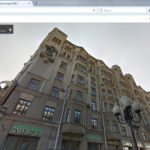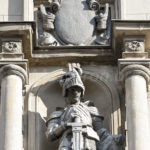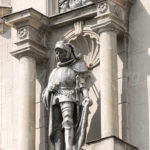Legend of the old Arbat. The Western Knight.
With a haughty look feudal Lord
Looks knight on the Arbat.
Like him, today there is little,
At the bottom is not seen something lats.
The last knight of the Arbat
Is the house for thirty-five.
His long enough,
He years might stand for.
Evgeny Agranovich, 1954. “The Last Knight in Arbat”
One of the beautiful legends of Moscow says that from four directions — north, south, east and west — the city is defended by knights. Choosing the object «Knight» on the site www.mascaron.org, and giving a little will of imagination, you can be sure that this legend is not without foundation. There have already been small posts about the southern and eastern knights, now we are talking about the «western» knight. More precisely, about two of them. As in the southern direction, to the west, two knights were put up for the defense of Moscow, which is marked on the project map — a blue mark with the number 2.
But the southern knight is now alone — in the 80s of the last century, during the renovation of the building, his «companion» disappeared without a trace … (perhaps now he patrols someone’s mansion :)). For the sake of justice, we must admit that there is also a second knight in the north direction (http://mascaron.org/?pid=902), but he does not perform the patrol function obviously :)!
Do not forget that now, in the updated version of the project site when the scale of the map is enlarged, or simply by «clicking» on the color mark with the number, it «opens up» and the objects themselves — in this case both Arbat Knights — will be marked with red marks.
Two western knights are located at the corner of the house 35 on Arbat Street: if you look at this building from the Vakhtangov Theater, their sentinel site is placed on the left corner tower on the 5th floor (you can take advantage of the “street view” option — just «drag» the yellow man from the lower right corner of the map on the street near the selected object). One of the knights looks at Arbat, the second into Kaloshin lane.
Arbat street, 35 from Vakhtangov theatre site
Knight from Arbat street view
Knight from Kaloshin lane view
Apparently, having decided to give a «heroic» spirit to the Moscow legends, someone invented a «story», as if on the right, symmetrical tower of the building there was also a knight, but he was “killed” (was destroyed) during one of the first bombings of Moscow at the beginning of the war in 1941. Indeed, almost exactly one month after the outbreak of the war — on the night of 22 (24?) July 1941, bomb destroyed the Vakhtangov Theater, hitting directly into the theater building, But the house 35 — directly opposite, at 20-25 meters — was not actually injured! Built in the beginning of the 20th century soundly! But the knight on the right tower of the building 35 on the Arbat street (practically opposite the point where the bomb hit the theater) simply did not exist: at the photographs of the 30s years of the 20th century it is evident that on the right tower there are niches really, but the windows of living apartments are visible behind them. Apparently, the project itself did not assume the installation of any sculptures in these niches initially. So this «heroic» legend about the “killed” knight on the Arbat street could not be confirmed by the facts.
Architect Valentin Dubovskoy with the participation of the engineer N.A. Arkhipov, with whom he often cooperated, built a profitable house on Arbat 35 in 1913-1914, commissioned by merchant I (by some sources -3rd?) Guild of Yakov Mikhailovich Filatov. Yakov Mikhailovich came from the Old Believers ‘family of the Filatovs of Bogorodsky Uyezd in the Moscow province and already in Moscow became the trustee of the Rogozhskaya Old Believers Community — the Moscow Old Believers’ Community of the Rogozhsky Cemetery (MSORK). (A noteworthy fact in connection with the legends of the «House» under the wineglass «, as it will be later, in subsequent posts). By 1914, Yakov Mikhailovich owned several warehouses and stores of electrical goods, and became an elected representative of the Moscow merchant class. The apartment house on the Arbat was recorded on Filatov’s wife — Anna Timofeevna, nee — Rassadkin, from a very wealthy mercharbat 35 was the second profitable house, which Filatov ordered the architect Dubovsky. Literally a year earlier, Valentin Dubovskaya built a lucrative house for Filatov on Ostozhenka 1, now known to the Muscovites as «House» under a wineglass». The apartment house on Arbat was intended for residing of rather well-founded tenants and differed with refined furnish of interiors. But there were only two entrances to the apartments on the left side of the building, where the knights are located. In the right part of the building there were a women’s gymnasium and private pension of Maria Ivanovna Zhits, as well as a kindergarten, which, according to some sources, was considered as one of the best. The gymnasium taught the pupils to several languages, and the ballerina of the Bolshoi Theater MA Volkov was invited to teach dance. Many gymnasium students lodged in the rooms here.
According to the recollections of the descendants, Yakov Mikhailovich Filatov was on friendly terms with the family of merchants Alexeyev. Konstantin Sergeevich Stanislavsky (Alexsev) came from the family. Of course, Stanislavsky often walked past the House with the Knight (Vakhtangov Theater directly opposite) and, most likely, he was here: perhaps, and visiting the Filatov (before the coup in 1917), and later, when well-known theater actress Vakhtangova Valentina Grigorievna Vagrina lived here. She was married to the chairman of “Soyuzpromexport”, David Kolmanovsky, and they both were suffered during the repression of the 1930s. By coincidence, Eduard Kolmonovsky (nephew of David Kolmanovsky), a well-known composer who also lived in a building with a knight, was not “touch” by these repressions.
Perhaps, Filatova’s profitable house is one of the most impressive buildings on the Arbat street. The neo-Gothic architecture of the «house with a knight» reminds old English (medieval) castles, which is also emphasized by the varied decor of the facade. On the website www.mascaron.org, specify in field Street — Arbat, in field house number (#) 35, do not forget to select the in the field Object- «All» instead of «Knight» 🙂 , to see all this decor. In addition to the knights, the façade is adorned with two lions (http://mascaron.org/?pid=599), a mysterious lady (unfortunately, with a completely lost face, apparently due to «repairs») with her faithful companion — a dog (http: // Mascaron.org/?pid=602). There is from the side of Arbat street also some kind of a small dragon — at the base of a decorative column (http://mascaron.org/?pid=1509), and some fantastic image on the wall behind the columns in the niches of the right tower of the facade on the 5th floor . But this is not all — practically under the roof on the facade of the house on the side of the Krivoiarbatsky lane Dubovskoy placed one more image of some fantastic, outlandish beast — most likely a unicorn! — http://mascaron.org/?pid=1511. And at the level of the first floor there is another panel — an image of a squirrel and, whether caressing, or ermine (specify in the filter the street — Krivoarbatsky and the house — 3). Fans of symbolism can find in these symbols (emblems) certain hints and the need for hard work to achieve the goal (the squirrel eating the kernel of the nut), and chastity and purity (ermine), which is quite appropriate in the context of the gymnasium located here.
Valentin Dubovskoy used a variety of decorations on the facades of most of his buildings. Often these were some strange images, for example, in Pomerancev Ln (http://mascaron.org/?pid=1297). But, what is noteworthy, medieval, chivalrous motifs were used in the area of Arbat (Bolshoy Afanasyevsky (http://mascaron.org/?pid=1846) and Bolshaya Nikolopeskovsky lanes (http://mascaron.org/?pid=605)) , Formed as it were a small Arbat medieval, gothic «enclave». Specify in the expanded (more) filter in the «Text in comments» field «Dubovskoy» to see the addresses of all these houses on the map. On the mobile device, you must first «activate» the «filter» window — the button to the right of the menu.
By the way, Dubovskoy built in …. 1926 the building of the famous HPP-1 on the Raushskaya Embankment. The architect was born in 1877 in St. Petersburg, and lived and worked mainly in Moscow. Valentin Dubovskoy, who created so many unique architectural works, largely shaped the face of Moscow, died in 1931. How surprisingly the sensation of a seemingly so distant history changes — literally only recently it was worth only «reach out», and one could literally «touch» the very history of the turn of the 19th and 20th centuries! Perhaps the memories of Valentin Evgenievich Dubovskoy or his family legends that reveal the riddle of symbolism on the facades of the architect’s creations are preserved.
Returning to the House with a knight on the Arbat street, it is worth noting its history and the history of its inhabitants. After the October coup of 1917, the wealthy tenants of the apartment house were gradually replaced by the functionaries of the new government (authority ). But their fate was mostly tragic — in the 30s years many, if not most, of them were repressed and left forever the Building with the knight on the Arbat. These uneasy, dramatic events of the history of Russia were described in Anatoly Rybakov’s novel «The Children of Arbat», who himself lived nearby — in house 51, a little further along Arbat street towards Smolenskay square. Later, in the 1950s and 1960s, part of the apartments were converted into communal apartments, and in 1975 the Ministry of Culture was located in the building with the knight. From 1992 to the present, the “House of Actors” named Yablochkina is housed here. The facade of the house can be said to have been very fortunate — neither war, nor repairs practically changed the architecture conceived by Dubovskoy, as well as the remarkable decor of the facades (with a few exceptions). Unfortunately, this can not be said about the interior of the house — only certain elements of the entrances interior were preserved, and most of the interior space was reconverted to the needs of the Ministry of Culture, and then of the “House of Actors”. By the way, on the 6th floor, the restaurant of the “House of Actor” exist now. Separated, unrelated with each other the halls of which are comfortably located in historical spaces — rooms of old apartments. And the restaurant’s menu has partly retained that «old» from the WTO (All-Russian Theater Society), described in the novel «Master and Margarita».
It want to believe that the “House of Actor” will save the inherited history and legends of «The House with the Knight», as it keeps the stories and of its old premises on Tverskaya Street. So, to the recently celebrated 80th anniversary of the “House of Actor” (February 14, 2017), “Novaya Gazeta” (newpaper) placed such a story preserved in the “House of Actor” related back to the 70s of the last century: «During his visit to Moscow, Marcello Mastroianni expressed a desire to see where the artists Drink, and he was taken to the restaurant of the House of Actor (old, on Tverskaya — note Mascaron.org). In honor of his arrival, «art historians in civilian clothes» dispersed all visitors in order not to compromise Soviet art, so Mastroianni came to an empty restaurant — he was explained that all the artists were playing and rehearsing. And only in the furthest corner of the restaurant did the Belokurov (Moscow Art Theater famous actor), who did not dare touch, he drank. When he saw Mastroianni, he was not at all surprised, poured a full glass of vodka and handed it to a foreign colleague. He shuddered, but drank. After that, Belokurov took him by the hair, looked into his eyes and said: «You are a good artist, son!»
It was impossible not to pass by the House with the Knight and the lovers of Mikhail Bulgakov. Bulgakov visited the theater of Vakhtangov many times, and, of course, could not help but pay attention to the Knights and the peculiar mystery of this house. From the «light hand» E. Agranovich believe that it was the Arbat Knight in part served as a prototype of Koroviev-Fagot. Here in this fragment from the scene of Margarita flight with Woland, someone catches hints at the Knight of the house of Filatova building:
“It would have been hard now to recognize Koroviev-Faggot, self-styled interpreter to the mysterious professor who needed none, in the figure who now rode immediately alongside Woland at Margarita’s right hand. In place of the person who had left Sparrow Hills in shabby circus clothes under the name of Koroviev-Faggot, there now galloped, the gold chain of his bridle chinking softly, a knight clad in dark violet with a grim and unsmiling face. He leaned his chin on his chest, looked neither at the moon nor the earth, thinking his own thoughts as he flew along beside Woland.
“Why has he changed so?” Margarita asked Woland above the hiss of the wind.
“That knight once made an ill-timed joke,” replied Woland, turning his fiery eye on Margarita. “Once when we were talking of darkness and light he made a somewhat unfortunate pun. As a penance he was condemned to spend rather more rime as a practical joker than he had bargained for. But tonight is one of those moments when accounts are settled. Our knight has paid his score and the account is closed.”
But the assumption that it was in the House with the Knight where Margarita crushed the flat of critic Latunsky, certainly does not stand up to any criticism. It was in a side street, most likely Bolshoy Nikolopeskovsky lane, that Margarita turned into from street, passing the theater on the Arbat: » She crossed the Arbat, rose higher, to fourth-floor level, and, past the dazzlingly bright tubes on the theatre building at the corner, floated into a narrow lane with tall buildings.» The truth in the lane Bulgakov replaced the standing» House Energy «on» House of the Dramlit «from Lavrushensry line, the facade of which is» lined with black marble, «and in which a prototype of the critic Latunsky lived likely
Of course, one can not help recalling the words of Bulat Shavlovich Okudzhava, as he was often called «the lonely knight of the Arbat»:
“One cannot be cured from that love of yours
Forty thousand other road-ways loving
Ah Arbat, my Arbat, you’re my one fatherland
One can never walk you through the very end”



